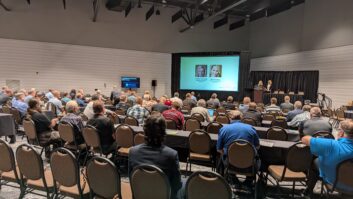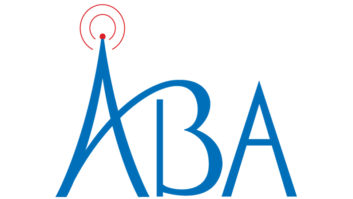I frequently exchange interesting websites with my old and new friends in radio and TV. Some sites might be broadcast related or a link to a great old video, while others might be a link to really cool new technology. Each week I’ll share some of the more interesting sites and group them in these regular blog posts called “Off the Beaten Path.” This episode is “AFRTS — The Brass Button Broadcasters, Part 2.”
Last week in Part 1, we visited a few web sites and some history about the American Forces Radio & TV Service (aka Armed Forces Radio & TV Service or AFRTS) and the training behind it. This week we’ll look at more details about some of the stations (detachments) and the real work and danger involved.

I mentioned that I felt that working for AFRTS was the most fun job in the military and I stand by what I say. But as much fun as the job itself might be, there is a very real danger by the nature of “the employer” in this case actually being the military.
I started out this column by trying to just include a few links that filled in some of the history, but the more I researched, the deeper “I dug the hole.” Since AFRTS has such a long history (and a history that geographically spans the entire globe), it was hard to keep this at just a couple of links and a single post. I’m sure that eventually I may produce a Part 3 and Part 4 to this.
AFVN — Vietnam
Most people have seen “Good Morning, Vietnam” and have an idea of AFVN from that movie, but incredibly, young 1st Lt. Steve Wiltsie filmed his AFRTS (AFVN) stations while serving in Vietnam. He’s placed the footage on You Tube and added narration. I found this an incredible “time capsule” of what things were like for military broadcasters in Vietnam. This 36-minute film footage and narration were absolutely captivating.
From reader Doug Jennings, AFVN 1970–71, AFN-Munich 1971–72, this link might be of interest, as it’s the official AFVN website. Jim White, MSG, AFVN Admin NCO, 1970–71, has done an excellent job of pulling together many sources of audio, video, pictures and more documenting the history of the network “Serving the American Fighting Man 24 Hours a Day From The Delta to The DMZ.”
If you’d like to hear the originator of “Goooooooooood morning, Vietnam,” you’ll enjoy the very first audio file. There’s a lot of interesting info here to explore. For instance, a great story on how Pat Sajak (real name is Sadjak) was a military accounting clerk who was recruited for AFVN. Be sure to look under “AFVN Roster.”
Armed Forces TV had its share of celebrities too. Here’s an entertaining video about Bobbie the Weather Girl. It’s very interesting to see what our own military aired as entertainment to our troops during Vietnam. It’s a great 40-minute film — including a clip of Bob Hope and a young Raquel Welch, in go-go boots, dancing up a storm at a USO show.
AFTN — Thailand
Over the years we’ve lost military broadcasters to accidents and war, but one of the most notable may have been what occurred at Udorn Air Base in Thailand back in April of 1970. The station, part of AFTN or Armed Forces Thailand Network, had about a dozen staff members and 10 were working the day an F-4 returning from North Vietnam with battle damage crashed into the station killing nine (reports indicated all but a civilian employee, a janitor, who was able to run out of the building though he was badly burned).
Here is a direct link to information regarding the accident. And a here’s link to photos from the AFTN Udorn crash (note that these are graphic and depict the tragedy visually).
AFN — Today
Here’s a much more recent video of some of the danger current AFRTS broadcasters face. Like military still photographers of WWII, AFRTS broadcasters (photojournalists) also see/record the destruction of war. At DINFOS (Defense INFOrmation School) there is a memorial to the members of AFRTS who have been lost over the years. It’s called “The Hall of Heroes” with over 100 names of those who lost their lives serving in the military with AFRTS. Note that there are some graphic images here.
Since radio and TV both enjoy reruns, I’ll give you a link again to a great web site for AFRTS history from a past column.
Here’s the AFN Europe link. Note that their streaming audio is blocked outside the area intended for broadcast, which basically means inaccessible in the continental U.S. This link will give you an idea of their programming today from a viewer/listener’s point of view.
And should any of this information entice anyone interested in working for AFRTS (and joining the military), here’s a link to the information guide DINFOS and the training.
On a personal note (and certainly not to knock the other branches), I served in the U.S. Air Force and quickly learned (and appreciated) one interesting difference between the other branches of the military concerning the job of “broadcaster” and “broadcast engineer.” While the jobs extend across all branches, I learned that if you are a Navy broadcaster (on a ship), if you go to battle, you shut down the station and either become a munitions person or fireman or whatever you are supposed to do. That certainly makes sense since no one is going to be watching or listening if the ship is in battle. In the Marines and Army, you grab a weapon because you’re a soldier or Marine first, broadcaster or engineer second.
But in the Air Force (at least back in 1986–90 when I was in), if something happens (like we go to war), you continue to broadcast and do what you were trained to do. We even practiced everything from master control TV operations to being on-the-air (DJ) in full chemical warfare gear (masks, rubber suits, gloves … the whole nine yards!). Just thought I’d point that out since it made me appreciate being a broadcaster (the career code was 791X1 back in my day) with the Air Force over the other branches since I’d probably shoot myself in the foot if someone let me hold a weapon. It was probably different for the brave men and women who worked for at stations “in harm’s way” during wartime.
Not to sound like a recruiter, but I can promise that the military training for broadcasters and engineers is probably the best training anywhere in the world (certainly the best FREE training) for broadcasting and broadcast engineering. My broadcast engineering friends were some of the best engineers I’ve ever known!
And finally …
Here’s a link to The Mind Unleashed website. This page is called “12 Dozen Places to Educate Yourself Online for Free.” Continuing education, especially in the field of communications (radio, TV and IT) is imperative to staying on top of the work we do. The MIT OpenCourseWare is an excellent resource. And free is always good.
If you stumble across a good or unusual web site that might be of interest, please don’t hesitate to send me the link and any info you might have about it. My email address is [email protected].







